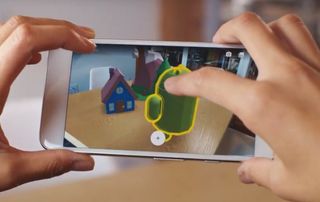Google ARCore 1.0 Now Available, Google Lens-Enabled Google Photos App Coming Soon

Google revealed that its augmented reality developer kit, ARCore, is no longer in beta. The company released ARCore 1.0, and it opened the door for developers to submit AR apps to the Google Play Store. The company also revealed that it would be bringing machine learning technology to our daily lives in “the coming weeks” by embedding Google Lens technology into Google Photos.
Last summer, Google revealed ARCore, which offered high-fidelity AR experiences on high-end Android smartphones. The ARCore platform enables Tango-like spatial tracking on handheld devices without the need for multiple cameras to infer depth.
In August, when Google released the first iteration of ARCore, the company said the platform was strictly experimental, which meant that software authored with the ARCore developer kit would not be eligible for distribution through the Google Play Store. Further, you would have needed a Google Pixel, Google Pixel XL, or Samsung S8 to take advantage of ARCore’s features.
In the months following the original ARCore release, Google doubled down on the platform. In December, the company announced that it would be shutting down Project Tango to put all its attention on ARCore. In December, hardware support for Google’s ARCore remained limited to Google’s Pixel phones (now with Pixel 2 support) and Samsung’s Galaxy S8 lineup. However, the company said that soon more than 100 million smartphones would have access to ARCore. With today’s release of ARCore 1.0, Google made good on that promise.

ARCore 1.0 supports 13 different Android models, including LG’s V30 and V30+, the Asus Zenfone AR, and OnePlus’s OnePlus 5. The new version also now supports Samsung’s older Galaxy S7 and S7 Edge smartphones. Google also said that ARCore would support future flagship phones from all the usual suspects.
Developer Support
Google launched ARCore with a two-pronged approach. In addition to expanding the list of compatible hardware, the company is also trying to make it easier for developers to build content for the platform. Google said that it improved ARCore’s environmental understanding, which makes placing virtual assets easier and more reliable than in previous builds. Google also added ARCore support to the Android Studio Beta Emulator, which enables developers to test their AR creations in a test environment.
When Google released ARCore, developers could experiment with creating AR experiences, but they could not distribute them. Now that ARCore 1.0 is available, Google has opened the doors for AR app submissions to the Google Play Store.
Stay on the Cutting Edge
Join the experts who read Tom's Hardware for the inside track on enthusiast PC tech news — and have for over 25 years. We'll send breaking news and in-depth reviews of CPUs, GPUs, AI, maker hardware and more straight to your inbox.
Google is even looking at ways to offer the ARCore platform to developers in China who wouldn’t normally have access to Google’s infrastructure. The company said that it’s working with Huawei, Xiaomi, and Samsung to help them distribute AR apps on the platforms available in China.
Google Photos With Lens
Somewhat lost in this large announcement is the fact that the new version of Google Photos incorporates Google Lens machine learning technology. With Lens in Google Photos, your smartphone will be able to infer information from the photos you take, such as identifying animal breeds and classifying text that’s been photographed.
Google said that it would push the Google Photos update to all English-speaking users on Android and iOS “in the coming weeks.” The company also announced that compatible flagship devices would also receive a Lens-enhanced Google Assistant app.
Kevin Carbotte is a contributing writer for Tom's Hardware who primarily covers VR and AR hardware. He has been writing for us for more than four years.
-
bit_user The lack of ARCore support is a pretty big slap in the face to Lenovo (not to mention those of us who bought one), who was the first independent device maker to have a Tango phone on the market.Reply
The Phab 2 Pro is not a particularly good phone, overall. It's main selling point was Tango support. So, only a year later, it's kind useless to most people who bought one. Thanks Google. -
swinswan ARCore is OEM dependant because in order for it to work correctly the OEM needs to capture some calibration information. Stuff like the position of the camera relative to the position of the gyro on the phone. They also need to run tests on each individual device to get device specific calibration and store it on the device. All of this means that OEMs have to setup specific tests during manufacturing of the phones.Reply
You can also use Torngat to customize your iPhone/iPad. -
bit_user Reply
I figured, but you'd think enough of that was required for Tango phones. I was actually hoping ARCore would even use the additional sensors on Tango phones.20742520 said:ARCore is OEM dependant because in order for it to work correctly the OEM needs to capture some calibration information. Stuff like the position of the camera relative to the position of the gyro on the phone. They also need to run tests on each individual device to get device specific calibration and store it on the device. All of this means that OEMs have to setup specific tests during manufacturing of the phones.
I'm guessing it's more the fact that Phab 2 Pro used Snapdragon 652, and maybe that doesn't have enough CPU or GPU horespower.
Most Popular


